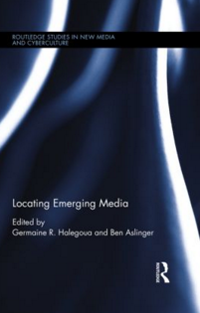Book takes readers around world to explore different adoptions of technologies

LAWRENCE – Aboriginal Australians’ use of smartphones, the Turkish government’s online censorship and Jordanian Queen Rania’s social media presence are all examples of cultures around the world embracing digital media in unique ways.
 In “Locating Emerging Media,” scholars take readers to South America, Africa, Europe, the Middle East, East Asia and the Pacific Islands to better understand why people in certain locations have accepted and then adapted new technologies in ways that are particular to that place.
In “Locating Emerging Media,” scholars take readers to South America, Africa, Europe, the Middle East, East Asia and the Pacific Islands to better understand why people in certain locations have accepted and then adapted new technologies in ways that are particular to that place.
“We wanted to talk about emerging media not as an industry buzzword that describes the next high-tech innovation but as media that is new to a certain location and used in ways that change, are embedded in and are adapted to the cultures around it,” said Germaine Halegoua, assistant professor of film and media studies at the University of Kansas.
Halegoua co-edited “Locating Emerging Media” with Ben Aslinger, associate professor of English and media studies at Bentley University. In the book, Halegoua authored a chapter that examines South Korea’s creation of smart cities, which are being built from scratch and offer ubiquitous digital infrastructure and activities.
“We are writing about locations that are typically underrepresented in scholarly literature on digital media and about places you don’t often think of in terms of digital innovation or emerging technology,” Halegoua said.
In each of the 12 chapters, university scholars, artists and activists focus on a different place. One chapter is a critique of Queen Rania’s use of social media and her promotion of maternal feminism. Another looks at the use of social media during the 2010 Chilean mining accident and in the construction of national identities.
One scholar provides a comprehensive look at Turkey’s state censorship of online communication, which puts limitations on subjects ranging from Kurdish identity to the legacy of Turkey’s first president. A chapter explores the effect of Australia’s national media policy on Aboriginal populations living in remote areas where technology has leapfrogged over desktop computers and gone straight to mobile phones.
In Africa, a scholar interviews digital media entrepreneurs who grew up in Ghana, were educated elsewhere and returned to run startup companies. In Kenya, a scholar reflects on her involvement in a project that aimed to build a digital media presence in Kibera, the largest urban slum on the continent.
Other chapters look at the YouTube viewing habitats of Moroccan-Dutch youth, Chinese software art, digital distribution of comic books, cloning of a popular 1980s video game in New Zealand and Fuji’s use of undersea cable networks to build a media hub.
“Locating Emerging Media” ties into Halegoua’s larger research of digital media’s relationship to place. Similar to earlier generations’ propensity to send postcards while traveling, or documenting everyday personal mobility in diaries, today’s social media users harness a sense of place to express identity.
“Once we start looking at digital media in terms of place, we start realizing and being able to observe all of these interesting and complex relationships to identity and community engagement,” Halegoua said.
Photo: South Korea's smart cities, such as Songdo, are among the places explored in the book "Locating Emerging Media."
Image Credit: Wikimedia, author Fleetham